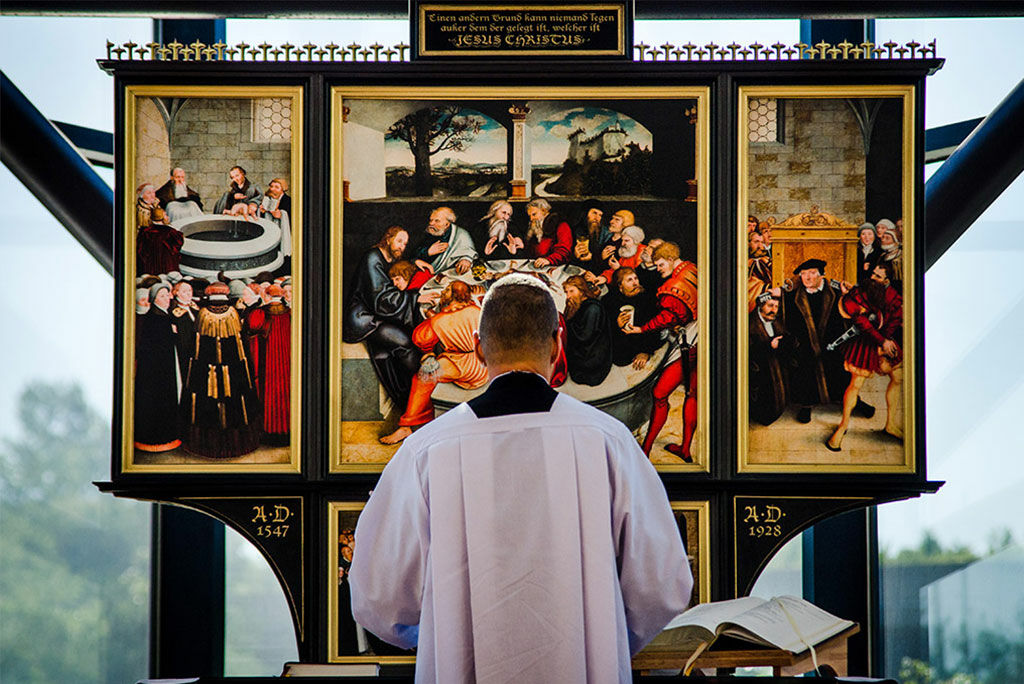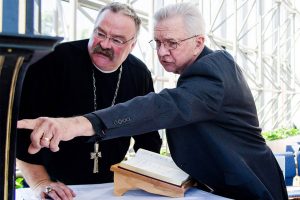
By Kevin Armbrust
A scale reproduction of the Cranach Reformation Altar art at St. Mary’s Church in Wittenberg, Germany, was blessed during a Sept. 19 service at the chapel of The Lutheran Church—Missouri Synod’s International Center (IC) in St. Louis.
Lucas Cranach the Elder, known as “the painter of the Reformation,” was a close friend of Martin and Katie Luther. Many familiar images of Martin Luther come from the brush of Cranach. Lucas Cranach the Younger was the second son of the Elder and worked with his father to complete the Reformation Altar in Wittenberg.
Rev. William C. Weedon, LCMS director of Worship and IC chaplain, blessed the new artwork in the Sept. 19 service. The Rev. Randall L. Golter, special assistant to the Synod president, preached on 1 John 5:1-5 and explained the imagery of the Reformation Altar piece. Golter noted, “Cranach and John point you to the life given in Jesus Christ.”

Cranach’s Reformation Altar art, installed in Wittenberg in 1547, contains a triptych resting on a fourth panel. The triptych depicts in order, from left, Baptism, the Lord’s Supper and the Office of the Keys. Prominent in these three scenes are Wittenberg Reformation figures Philip Melanchthon, Martin Luther and Johannes Bugenhagen.
Underneath these three panels Cranach painted Christ crucified, the foundation upon which the Reformation was established and the Church is built. This bottom panel depicts the congregation on the left, listening to Luther preach from the right side of the panel. Luther’s one hand rests on the Scripture and the other points to Christ. Jesus is in the middle of the panel — the focus of the Word and the foundation of the Reformation.
After the service, LCMS President Rev. Dr. Matthew C. Harrison explained the historical context of the Reformation Altar.
“Luther was dead. And Wittenberg was captured. … It was the worst moment in history of the Evangelical movement,” said Harrison. “It was right in the midst of the greatest difficulties that Cranach makes this painting.”
Harrison introduced the Rev. Dr. William Matzat, the craftsman responsible for overseeing the reproduction project, saying, “There was one man to do the work — Pastor Matzat, who is an artist’s artist.”
The reproduction, which is about one-third the size of the original, contains prints of Cranach’s paintings set in wood panels. In order to construct this altar piece, Matzat crafted hundreds of feet of custom molds.
Matzat explained that the top piece, inscribed with the words of 1 Cor. 3:11 in German (which translated says, “For no one can lay a foundation other than that which is laid, which is Jesus Christ”), is one feature present in this reproduction that is often missing from other reproductions. This text is essential to the Reformation Altar, for there the foundation is established: Jesus Christ.
Matzat later said, “In all my work I seek to express the Gospel of Jesus Christ.” The Reformation Altar proclaims Christ as the foundation of the Church and the Reformation. Matzat explained, “For the Reformation, the Word is the key. The Word is Christ.”
Dr. Kevin Armbrust (kevin.armbrust@lcms.org) is manager of Editorial Services for LCMS Communications.
Posted September 22, 2016
